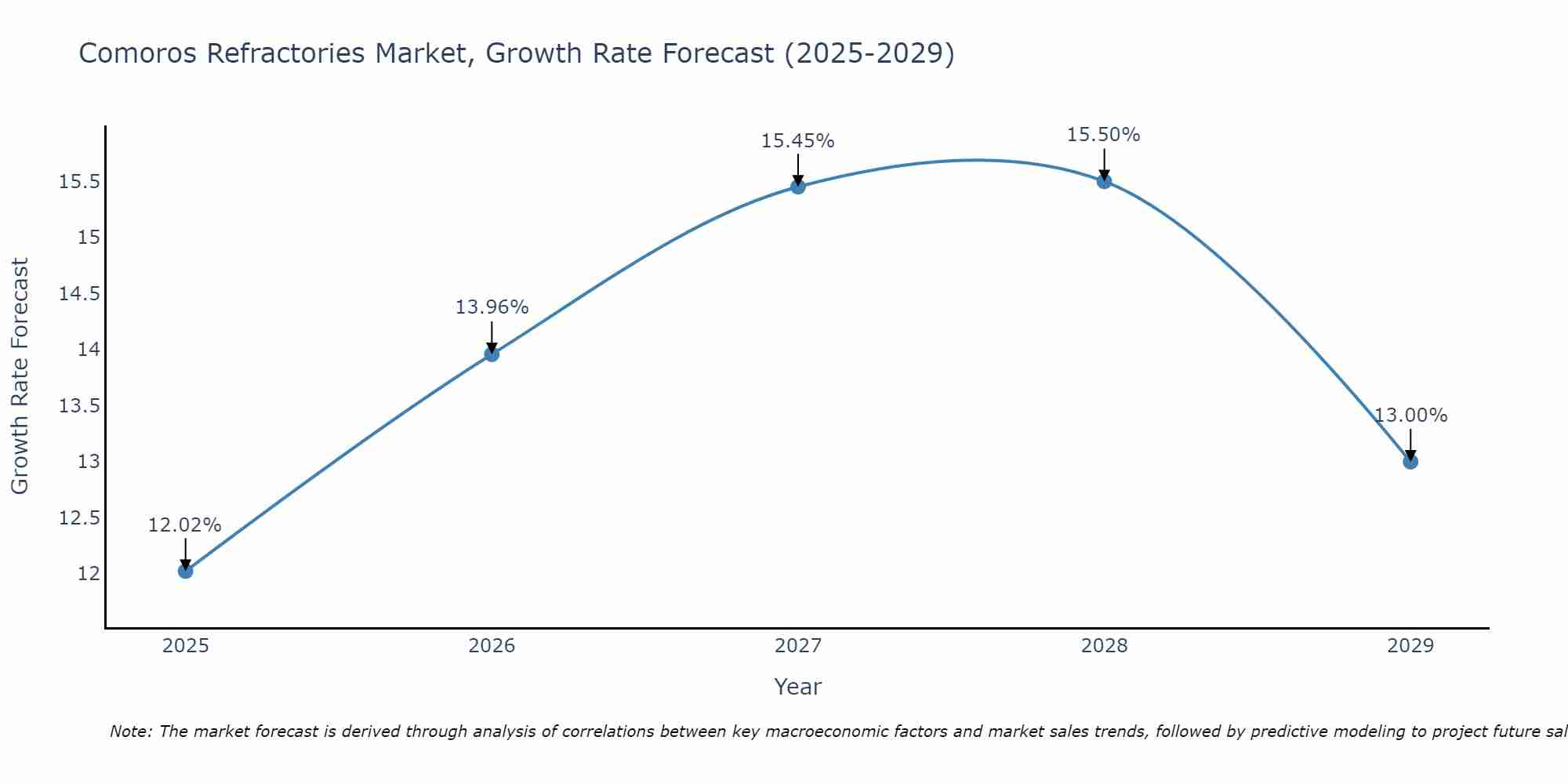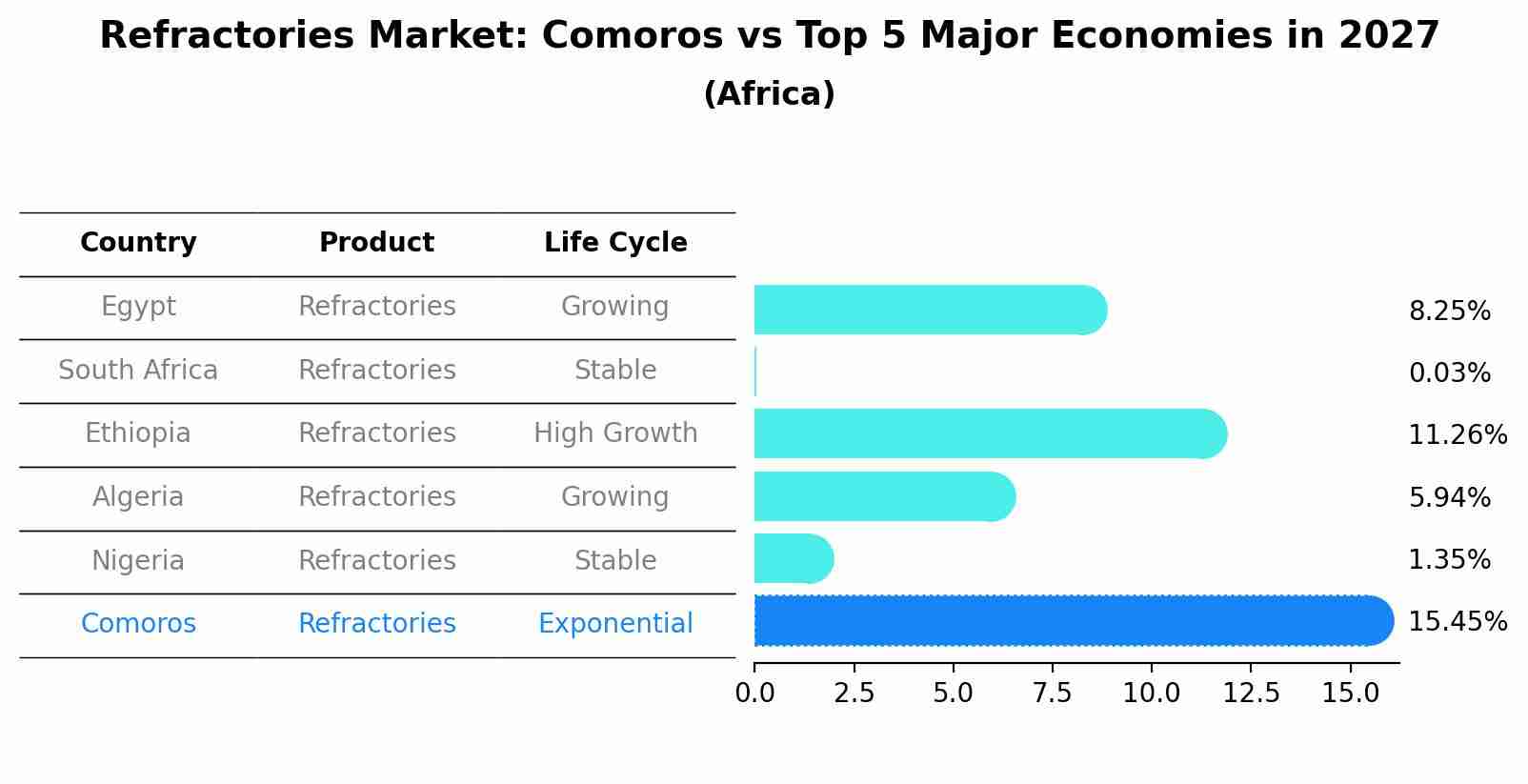Comoros Refractories Market (2025-2031) | Trends, Share, Revenue, Outlook, Value, Size, Industry, Growth, Analysis, Forecast, Companies & Segmentation
| Product Code: ETC4654752 | Publication Date: Nov 2023 | Updated Date: Apr 2025 | Product Type: Market Research Report | |
| Publisher: 6Wresearch | Author: Shubham Deep | No. of Pages: 60 | No. of Figures: 30 | No. of Tables: 5 |
Comoros Refractories Market Size Growth Rate
The Comoros Refractories Market is projected to witness mixed growth rate patterns during 2025 to 2029. Growth accelerates to 15.50% in 2028, following an initial rate of 12.02%, before easing to 13.00% at the end of the period.

Refractories Market: Comoros vs Top 5 Major Economies in 2027 (Africa)
By 2027, the Refractories market in Comoros is anticipated to reach a growth rate of 15.45%, as part of an increasingly competitive Africa region, where Egypt remains at the forefront, supported by South Africa, Ethiopia, Algeria and Nigeria, driving innovations and market adoption across sectors.

Comoros Refractories Market Overview
Refractories in Comoros are essential for high-temperature processes in industries such as steelmaking, cement production, and glass manufacturing. The market is driven by the expansion of industrial activities and infrastructure development. Refractories must withstand extreme conditions, making them crucial for maintaining operational efficiency. However, the market faces challenges such as fluctuating raw material prices and the need for technological advancements to improve the performance and longevity of refractory products.
Drivers of the market
The Comoros refractories market is driven by the growth of the construction and manufacturing industries. Refractories, which are heat-resistant materials used in high-temperature environments, are essential in sectors such as metallurgy, cement, and glass production. The expansion of industrial activities, coupled with the need for energy-efficient and durable materials, is fueling the demand for refractories. Additionally, infrastructure development and increased investments in industrial facilities are contributing to market growth.
Challenges of the market
The Comoros refractories market faces several challenges, including the scarcity of raw materials and high transportation costs for importing these materials. The market is also hindered by the lack of local production facilities, which results in reliance on international suppliers and fluctuating prices. Additionally, there is a limited understanding of advanced refractory technologies among local businesses, which affects the adoption and use of high-quality refractories.
Government Policy of the market
Regulations governing the refractories market in Comoros focus on ensuring product quality and safety in high-temperature applications. The government enforces standards for refractories used in industries such as metallurgy and cement production. There are policies in place to support local manufacturing and reduce dependency on imports by providing incentives and subsidies to domestic producers. Additionally, there are initiatives aimed at promoting research and development in refractory materials to enhance their performance and sustainability.
Key Highlights of the Report:
- Comoros Refractories Market Outlook
- Market Size of Comoros Refractories Market, 2024
- Forecast of Comoros Refractories Market, 2031
- Historical Data and Forecast of Comoros Refractories Revenues & Volume for the Period 2021-2031
- Comoros Refractories Market Trend Evolution
- Comoros Refractories Market Drivers and Challenges
- Comoros Refractories Price Trends
- Comoros Refractories Porter`s Five Forces
- Comoros Refractories Industry Life Cycle
- Historical Data and Forecast of Comoros Refractories Market Revenues & Volume By Form Types for the Period 2021-2031
- Historical Data and Forecast of Comoros Refractories Market Revenues & Volume By Shaped Refractories for the Period 2021-2031
- Historical Data and Forecast of Comoros Refractories Market Revenues & Volume By Unshaped Refractories for the Period 2021-2031
- Historical Data and Forecast of Comoros Refractories Market Revenues & Volume By Product Types for the Period 2021-2031
- Historical Data and Forecast of Comoros Refractories Market Revenues & Volume By Non-clay Refractory for the Period 2021-2031
- Historical Data and Forecast of Comoros Refractories Market Revenues & Volume By Clay Refractory for the Period 2021-2031
- Historical Data and Forecast of Comoros Refractories Market Revenues & Volume By End-users for the Period 2021-2031
- Historical Data and Forecast of Comoros Refractories Market Revenues & Volume By Iron & Steel for the Period 2021-2031
- Historical Data and Forecast of Comoros Refractories Market Revenues & Volume By Cement for the Period 2021-2031
- Historical Data and Forecast of Comoros Refractories Market Revenues & Volume By Non-Ferrous Metals for the Period 2021-2031
- Historical Data and Forecast of Comoros Refractories Market Revenues & Volume By Glass for the Period 2021-2031
- Historical Data and Forecast of Comoros Refractories Market Revenues & Volume By Others for the Period 2021-2031
- Comoros Refractories Import Export Trade Statistics
- Market Opportunity Assessment By Form Types
- Market Opportunity Assessment By Product Types
- Market Opportunity Assessment By End-users
- Comoros Refractories Top Companies Market Share
- Comoros Refractories Competitive Benchmarking By Technical and Operational Parameters
- Comoros Refractories Company Profiles
- Comoros Refractories Key Strategic Recommendations
Frequently Asked Questions About the Market Study (FAQs):
1 Executive Summary |
2 Introduction |
2.1 Key Highlights of the Report |
2.2 Report Description |
2.3 Market Scope & Segmentation |
2.4 Research Methodology |
2.5 Assumptions |
3 Comoros Refractories Market Overview |
3.1 Comoros Country Macro Economic Indicators |
3.2 Comoros Refractories Market Revenues & Volume, 2021 & 2031F |
3.3 Comoros Refractories Market - Industry Life Cycle |
3.4 Comoros Refractories Market - Porter's Five Forces |
3.5 Comoros Refractories Market Revenues & Volume Share, By Form Types, 2021 & 2031F |
3.6 Comoros Refractories Market Revenues & Volume Share, By Product Types, 2021 & 2031F |
3.7 Comoros Refractories Market Revenues & Volume Share, By End-users, 2021 & 2031F |
4 Comoros Refractories Market Dynamics |
4.1 Impact Analysis |
4.2 Market Drivers |
4.3 Market Restraints |
5 Comoros Refractories Market Trends |
6 Comoros Refractories Market Segmentations |
6.1 Comoros Refractories Market, By Form Types |
6.1.1 Overview and Analysis |
6.1.2 Comoros Refractories Market Revenues & Volume, By Shaped Refractories, 2021-2031F |
6.1.3 Comoros Refractories Market Revenues & Volume, By Unshaped Refractories, 2021-2031F |
6.2 Comoros Refractories Market, By Product Types |
6.2.1 Overview and Analysis |
6.2.2 Comoros Refractories Market Revenues & Volume, By Non-clay Refractory, 2021-2031F |
6.2.3 Comoros Refractories Market Revenues & Volume, By Clay Refractory, 2021-2031F |
6.3 Comoros Refractories Market, By End-users |
6.3.1 Overview and Analysis |
6.3.2 Comoros Refractories Market Revenues & Volume, By Iron & Steel, 2021-2031F |
6.3.3 Comoros Refractories Market Revenues & Volume, By Cement, 2021-2031F |
6.3.4 Comoros Refractories Market Revenues & Volume, By Non-Ferrous Metals, 2021-2031F |
6.3.5 Comoros Refractories Market Revenues & Volume, By Glass, 2021-2031F |
6.3.6 Comoros Refractories Market Revenues & Volume, By Others, 2021-2031F |
7 Comoros Refractories Market Import-Export Trade Statistics |
7.1 Comoros Refractories Market Export to Major Countries |
7.2 Comoros Refractories Market Imports from Major Countries |
8 Comoros Refractories Market Key Performance Indicators |
9 Comoros Refractories Market - Opportunity Assessment |
9.1 Comoros Refractories Market Opportunity Assessment, By Form Types, 2021 & 2031F |
9.2 Comoros Refractories Market Opportunity Assessment, By Product Types, 2021 & 2031F |
9.3 Comoros Refractories Market Opportunity Assessment, By End-users, 2021 & 2031F |
10 Comoros Refractories Market - Competitive Landscape |
10.1 Comoros Refractories Market Revenue Share, By Companies, 2024 |
10.2 Comoros Refractories Market Competitive Benchmarking, By Operating and Technical Parameters |
11 Company Profiles |
12 Recommendations | 13 Disclaimer |
- Single User License$ 1,995
- Department License$ 2,400
- Site License$ 3,120
- Global License$ 3,795
Search
Thought Leadership and Analyst Meet
Our Clients
Related Reports
- Canada Oil and Gas Market (2026-2032) | Share, Segmentation, Value, Industry, Trends, Forecast, Analysis, Size & Revenue, Growth, Competitive Landscape, Outlook, Companies
- Germany Breakfast Food Market (2026-2032) | Industry, Share, Growth, Size, Companies, Value, Analysis, Revenue, Trends, Forecast & Outlook
- Australia Briquette Market (2025-2031) | Growth, Size, Revenue, Forecast, Analysis, Trends, Value, Share, Industry & Companies
- Vietnam System Integrator Market (2025-2031) | Size, Companies, Analysis, Industry, Value, Forecast, Growth, Trends, Revenue & Share
- ASEAN and Thailand Brain Health Supplements Market (2025-2031) | Strategy, Consumer Insights, Analysis, Investment Trends, Opportunities, Growth, Size, Share, Industry, Revenue, Segments, Value, Segmentation, Supply, Forecast, Restraints, Outlook, Competition, Drivers, Trends, Demand, Pricing Analysis, Competitive, Strategic Insights, Companies, Challenges
- ASEAN Bearings Market (2025-2031) | Strategy, Consumer Insights, Analysis, Investment Trends, Opportunities, Growth, Size, Share, Industry, Revenue, Segments, Value, Segmentation, Supply, Forecast, Restraints, Outlook, Competition, Drivers, Trends, Demand, Pricing Analysis, Competitive, Strategic Insights, Companies, Challenges
- Europe Flooring Market (2025-2031) | Outlook, Share, Industry, Trends, Forecast, Companies, Revenue, Size, Analysis, Growth & Value
- Saudi Arabia Manlift Market (2025-2031) | Outlook, Size, Growth, Trends, Companies, Industry, Revenue, Value, Share, Forecast & Analysis
- Uganda Excavator, Crane, and Wheel Loaders Market (2025-2031) | Strategy, Consumer Insights, Analysis, Investment Trends, Opportunities, Growth, Size, Share, Industry, Revenue, Segments, Value, Segmentation, Supply, Forecast, Restraints, Outlook, Competition, Drivers, Trends, Demand, Pricing Analysis, Competitive, Strategic Insights, Companies, Challenges
- Rwanda Excavator, Crane, and Wheel Loaders Market (2025-2031) | Strategy, Consumer Insights, Analysis, Investment Trends, Opportunities, Growth, Size, Share, Industry, Revenue, Segments, Value, Segmentation, Supply, Forecast, Restraints, Outlook, Competition, Drivers, Trends, Demand, Pricing Analysis, Competitive, Strategic Insights, Companies, Challenges
Industry Events and Analyst Meet
Whitepaper
- Middle East & Africa Commercial Security Market Click here to view more.
- Middle East & Africa Fire Safety Systems & Equipment Market Click here to view more.
- GCC Drone Market Click here to view more.
- Middle East Lighting Fixture Market Click here to view more.
- GCC Physical & Perimeter Security Market Click here to view more.
6WResearch In News
- Doha a strategic location for EV manufacturing hub: IPA Qatar
- Demand for luxury TVs surging in the GCC, says Samsung
- Empowering Growth: The Thriving Journey of Bangladesh’s Cable Industry
- Demand for luxury TVs surging in the GCC, says Samsung
- Video call with a traditional healer? Once unthinkable, it’s now common in South Africa
- Intelligent Buildings To Smooth GCC’s Path To Net Zero


















